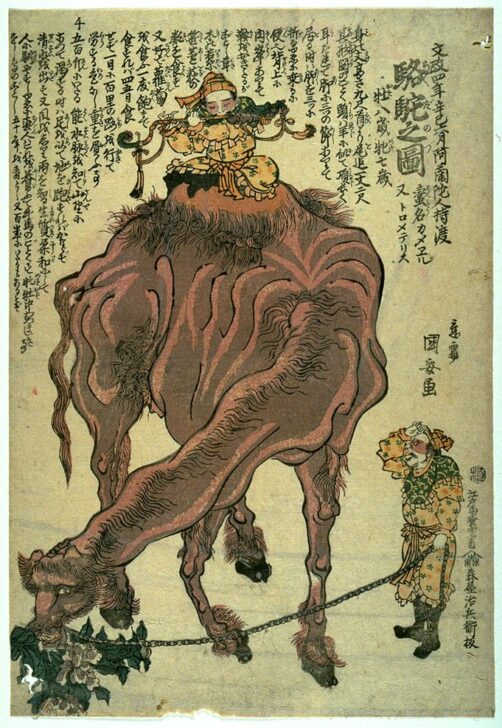Camel
Utagawa Kuniyasu

Description
According to the inscription on this woodcut, the Dutch introduced the camel to Japan in 1821. Intrigued by these exotic beasts, the Japanese fed them hibiscus blossoms, a fancy food befitting such fabulous creatures.
*Gallery Rotation Spring 2009
Utagawa Kuniyasu
Japan, 1794–1832
Camels
Edo Period (1615–1868)
circa 1824
Color woodblock print on paper
Museum purchase for the Paul Leroy Grigaut Memorial Collection, 1969/2.90, 1969/2.91
During the Edo Period, Japan was secluded from diplomatic and trade relationships with other countries, with the exceptions of Korea, China, and the Netherlands. The man-made island of Deshima in Nagasaki bay (in the southwestern part of Japan, Kyûshû Island,) was the only port open for foreign contact. A type of woodblock print called Nagasaki-e became widely popular, depicting the foreign traders and exotic animals that came through the Deshima port.
In 1821, the Dutch brought a pair of female and male Arabian camels to Japan, and they were a huge sensation, eventually touring to major cities including Edo, Osaka, and Kyoto. Popular novelist Santôan Kyôzan detailed the animals’ physiognomy, diet, origins, and habitat to satisfy people’s curiosity. In this print, artist Utagawa Kuniyasu depicted the camels and entertainers who accompanied the show.
Subject Matter:
This double-leaf print depicts two camels and accompanying foreign trainers or performers in fringed clothing, with ballooning pants and dark boots. They may be from Portugal, Central Asia, or China, and have come with the pair of Arabia camels on a tour of Japan beginning in 1821, stopping in Osaka, Kyoto, and Edo, where Utagawa resided.
Some of the performers play instruments, while others tend to the camels. Above both pages is writing by calligrapher Santô Kyôden describing the camels and their trip. Exotic animal and foreigner prints such as these are typical of Nagasaki-e, depictions of trade and goods from foreign lands that came through the port of Deshima in Nagasaki Bay during the National Seclusion Policy (1639-1854).
Physical Description:
This double-leaf print depicts two camels and accompanying foreign trainers or performers in fringed clothing, with ballooning pants and dark boots. Some of the performers play instruments, while others tend to the camels. Above both pages is writing by calligrapher Santô Kyôden describing the camels and their tour of Japan around 1821.
Usage Rights:
If you are interested in using an image for a publication, please visit https://umma.umich.edu/request-image/ for more information and to fill out the online Image Rights and Reproductions Request Form.